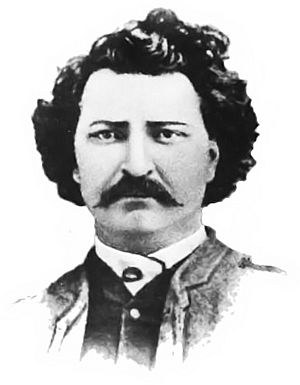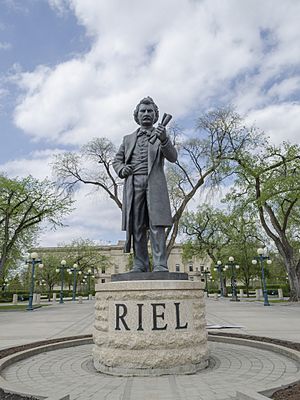Louis Riel facts for kids
Quick facts for kids
Louis Riel
|
|
|---|---|
 |
|
| President of the Provisional Government, then, Legislative Assembly of Assiniboia | |
| In office 27 December 1869 – 24 June 1870 |
|
| Member of Parliament for Provencher |
|
| In office 13 October 1873 – 16 April 1874 |
|
| Preceded by | George-Étienne Cartier |
| In office 13 September 1874 – 25 February 1875 |
|
| Succeeded by | Andrew Bannatyne |
| Personal details | |
| Born | 22 October 1844 St. Boniface, Red River Colony, Rupert's Land |
| Died | 16 November 1885 (aged 41) Regina, North-West Territories, Canada |
| Spouse |
Marguerite Monet dite Bellehumeur
(m. 1881) |
| Children | 2 |
| Signature |  |
Louis Riel (born October 22, 1844 – died November 16, 1885) was an important Canadian politician. He helped create the province of Manitoba. Riel was also a key leader for the Métis people. He led two movements to protect Métis rights and culture. Many people today see him as a Canadian hero.
Contents
Louis Riel's Early Life
Louis Riel was born in 1844 in St-Boniface. This area was near the Red and Seine rivers. He was the oldest of eleven children. His family was well-known and respected. They were known for their strong Catholic faith and close family bonds.
Riel started school when he was seven. By age ten, he attended Catholic schools in St. Boniface. When he was thirteen, Bishop Alexandre-Antonin Taché noticed him. The Bishop wanted talented young Métis to become priests. In 1858, Taché arranged for Riel to study at the Petit Séminaire in Montreal.
Riel was a good student. He was skilled in languages, science, and philosophy. However, he could also be quick-tempered. He sometimes argued with his teachers.
After his father died in 1864, Riel left college in March 1865. He continued studying for a short time. He worked as a law clerk in Montreal. Riel did not enjoy legal work. By 1866, he decided to leave Canada East. He took various jobs in Chicago and Saint Paul, Minnesota.
Becoming a Métis Leader
Riel returned to the Red River settlement on July 26, 1868. Most people in the Red River area were Métis and First Nations people. When Riel came back, he found his people were worried. New settlers from Ontario were arriving. These settlers wanted to take their land.
Riel and his supporters decided to act. They wanted to talk with the Canadian government. At first, the government did not listen. To get their attention, Riel started the Red River Resistance in 1869–1870. He formed a provisional government. This government then negotiated for Manitoba to join the Canadian Confederation.
During this time, Riel's people took some prisoners. One prisoner was named Thomas Scott. Scott often acted disrespectfully. He even attacked one of Riel's men. Riel decided to put Scott on trial. A jury, including some of Riel's trusted men, found Scott guilty. He was sentenced to death and executed by a firing squad.
Challenges and Exile
People in Ontario were very angry about Scott's execution. A military group called the Wolseley Expedition was sent to stop the resistance. Riel had to flee to the United States to avoid being arrested. While he was in exile, he was elected three times as a Member of Parliament. But he could never take his seat in the House of Commons because he feared for his life. During this time, he also believed he was a special leader chosen by God. He received treatment for his health.
By 1884, Riel was married and teaching school. He lived at the St. Peter's Jesuit mission in Montana.
His Final Stand
In 1884, Métis leaders in Saskatchewan asked Riel for help. They had problems with the Canadian government. Riel came to help them. However, he was captured and imprisoned in Regina. He was put on trial and found guilty of high treason. Many people protested and asked for mercy. But Riel was executed by hanging on November 16, 1885, in Regina.
Riel's execution had a big and lasting impact on Canada. It caused a lot of disagreement among people.
Family Life
Riel had a relationship with a young woman named Marie–Julie Guernon. However, her family did not approve of her marrying a Métis man. The engagement ended.
In 1881, while in exile, he married Marguerite Monet dite Bellehumeur. She was a young Métis woman. Marguerite and Louis had three children: Jean-Louis (1882–1908), Marie-Angélique (1883–1897), and a baby boy who was born and died on October 21, 1885.
Remembering Louis Riel

There are two statues of Riel in Winnipeg. One statue, created by Étienne Gaboury and Marcien Lemay, showed Riel as a suffering figure. It was put up in 1971. After many people, especially the Métis community, said it was not respectful, it was moved. It is now at the Université de Saint-Boniface. A new statue by Miguel Joyal replaced it in 1996. This one shows Riel as a respected statesman. A similar statue in Regina was also moved for similar reasons.
Many places across Canada are named after Riel. These include streets, schools, and buildings. In Winnipeg, there is the Esplanade Riel pedestrian bridge. The Louis Riel School Division is also named after him. The student center at the University of Saskatchewan is named for Riel. There are schools named Louis Riel in Calgary, Montreal, Ottawa, and Winnipeg.
Riel's story has been told in many ways. The CBC made a TV film called Riel in 1979. Chester Brown created a graphic novel about him in 2003, called Louis Riel: A Comic-Strip Biography. An opera about Riel, titled Louis Riel, was made for Canada's centennial in 1967.
Quick Facts About Riel
- Riel became a citizen of the United States on March 16, 1883.
- Since the 1980s, some politicians have tried to officially pardon Riel. They also want him recognized as a Father of Confederation.
- In 1992, the House of Commons officially recognized Riel. They noted his "unique and historic role" in founding Manitoba. They also recognized his help in developing Canada.
- In a public vote for the CBC's Greatest Canadian project, Riel was ranked 11th.
- In 2007, Manitoba made Louis Riel Day a provincial holiday. It is celebrated on the third Monday of February.
See also
 In Spanish: Louis Riel para niños
In Spanish: Louis Riel para niños
Images for kids







